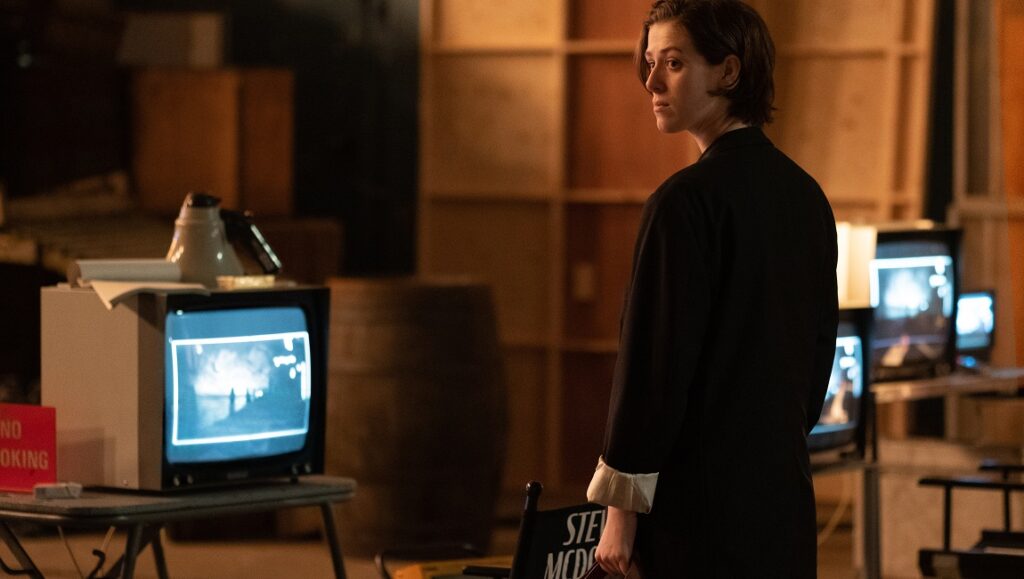The Souvenir: Part II plays out largely as protracted epilogue, a fumbling, detached work that negates the first film’s powerful ending.
Jean-Honoré Fragonard’s 1778 painting “The Souvenir,” which captures with Rococo gentility a young woman carving her lover’s initials into a tree, is the central object and metaphor of Joanna Hogg’s quietly dazzling 2019 feature which shares its title. In it, a young film student, Julie (Honor Swinton Byrne) receives a postcard-sized reproduction of the artwork slipped under her door by Anthony (Tom Burke) marking the start of their tumultuous relationship. Eventually, the burden of Anthony’s toxicity (magnified by the heroin use which leads to his untimely death) brands Julie, like the carved tree, with a lasting souvenir of their relationship; a young love is curdled into grief. The film ends on a shot of her standing before a large set of soundstage hangar doors, shut earlier but now thrust open to reveal a lush landscape beyond them. Hogg beckons us to exit as well, dropping the credits just as Julie walks out toward an uncertain future, leaving the encompassing pain and tragedy of the present behind her. For all of The Souvenir’s bold stylistic choices — bounding with ease from 16mm to Super 8 to still photography, and back — none approach the audacity of dashing the beautiful precision of this conclusion with a promise (tucked 007-style at the end of the credit scroll) that Souvenir: Part II is on the way.
Surprising at first glance, this decision makes more sense with a grasp of how profoundly autobiographical the film really is and the extent to which Hogg has inserted parts of herself into it. From a reconstruction of her ‘80s London flat to journals and letters used as inspiration, inserted photographs, and footage, its dramatized world is populated by shards and artifacts tethered to a real set of events, a real artist, and a real, tragic loss. Hogg explains in interviews that she had long envisioned the film in two parts, with the second forming an expanded look at Julie as an artist whose work becomes informed by the tragedy of the first. In fact, Hogg’s autobiographical forthrightness in The Souvenir unlocks a new resonance to the themes of absence and loss that pulsate through Unrelated, Archipelago, and Exhibition, her trilogy of features that preceded it.
The trouble with The Souvenir: Part II, however, is that it lacks a driving force, and for the first time, Hogg, a director whose idiosyncratic filmography has been marked by confidence, appears to be grasping in the dark. The result is a protracted epilogue to a film that never needed one, with several distinct ideas moving in several directions and hoping to cover enough ground to create the impression of a whole. The first trails down the trajectory of Julie’s grief, exemplified by melancholy trips to her parent’s villa; the second tracks her artistic process through the development of her student film; the third follows her attempts to reconcile her idea of Anthony with the truth of who he was; and the fourth concerns itself with stymied love affairs and false starts. This may read as robust on paper, but the individual segments feel paltry, no longer intertwined, and instead have the air of deleted scenes from the previous chapter — like an album of B-sides and leftovers from a great record. Julie’s emotional state, which in The Souvenir served as an anchor, becomes more inscrutable, particularly as the focus shifts to her student film: a recreation of her relationship bombastically titled The Souvenir as well. Following the gripping sincerity of the previous film, the decision to double down on this too-clever-by-half meta deconstruction plays like a tactical retreat, an act of emotional disengagement from the heart of the material.
This move sadly undercuts the same vibrant visuals that made The Souvenir feel so rich. The Souvenir: Part II once again has a sumptuous collage of styles, including shifting film stocks and aspect ratios, color and black-&-white, and the culminating centerpiece: a remarkable homage to Hogg’s Powell and Pressburger-indebted student film Caprice (which once featured a young Tilda Swinton in her first role, and now stars her daughter Honor Swinton Byrne). But even this phantasmagoric climax recalling The Red Shoes feels sloppily out of place, mechanical, and untethered from the emotive foundation ostensibly driving it. In an earlier scene, the school board questions Julie’s new script: “Where has that world gone?” they ask, referring explicitly to her abandoning a documentary project in favor of an autobiographical shift. This question lingers in the air here, as we watch the same gorgeously composed images of The Souvenir become so devoid of feeling or power. This aspect becomes most obvious in looking at The Souvenir: Part II’s ending, which reduces Julie to a mere character; her pain, her grief, her creative ambitions all caught in a loop of artifice, nothing but a film within a film. The ending closes on an indulgent reminder of Joanna Hogg’s presence and shuffles off the world of The Souvenir with ironic distance and detachment; a negation of the original ending which had once brandished its fearless sincerity as both sword and shield.
Originally published as part of New York Film Festival 2021 — Dispatch 2.


Comments are closed.